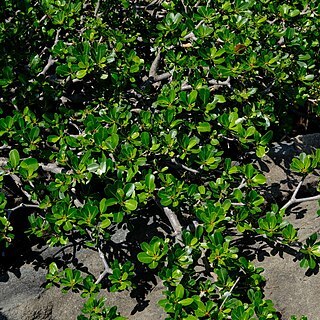Shrub or small tree, up to 15 m tall; much branched; vegetative parts glabrous, or at least very soon glabrous. Leaves crowded at the ends of the twigs but not strictly terminal as in the next species, varying from obovate-oblong to narrowly spathulate-oblong, sometimes elliptic or elliptic-oblong, with the greatest width just above the middle, 2-5 cm, rarely up to 8-5 cm long and 1-3.5 cm wide, coriaceous, glabrous, margin subreflexed, apex emarginate or retuse, rarely rounded, base narrowed, but never very acute; petioles semi-terete, rather stout, 3-8 mm long. Flowers in the axils of the leaves and of scars of fallen leaves, fasciculate, often very numerous, 3-merous or sometimes 3-merous and 4-merous on one specimen; pedicels comparatively stout, terete. Sepals ovate or ovate-elliptic, obtuse, about 3-5 mm long; the outer ones tomentose outside and inside near the apex, 2-2.5 mm wide; the inner ones thinner, more petaloid, slightly narrower, about 2 mm wide, vaguely midribbed, whitish-tomentose outside, glabrous inside. Corolla yellow or yellowish, glabrous; tube 0.75-1 mm long; lobesoblong-linear or oblanceolate-spathulate, obtuse or rounded, with a very narrow base, 3-3. 5 mm long and about 0ú75 mm wide; the appendages about as long and wide, but from a broad base Ianceolate-linear, acute or acuminate, often with a few coarse serrations near the apex. Staminodes glabrous, fleshy, usually ovate-suborbicular or subquadrate, and much shorter than the filaments, usually more or less trilobed or tridentate, occasionally some produced into thin filiform apical portions, if so, equalling or longer than the stamens. Filaments 1.5-2 mm long, glabrous; anthers somewhat sagittate, apiculate, 1-1.5 mm long. Ovary semiglobose-conical, faintly lobed, hairy, nearly 1 mm long and about 1.25 mm in diameter, style rather thick, subulate, glabrous and truncate, about 2.5 mm long. Berry one-or two-seeded, edible, ellipsoid or subglobose, 10-15 mm long and 8-15 mm in diameter. Seeds obovoid, hardly compressed when single, often with one flattened lateral side when from a 2-seeded fruit, obliquely truncate at the base, 9-11 mm long, 6.5-8 mm wide, those of 1-seeded fruits 5-7 mm thick, those from 2-seeded fruits 3-5 mm thick; testa brown, smooth and shiny, hard; scar ovate, oblong or elliptic, occupying the truncate basi-lateral side of the seed, 6-8 mm long and about 3 mm wide.
More
A tree with a pear shape. It can grow to 22 m tall. The trunk can be 1.2 m across. In drier places it is lower and more spreading. The leaves are crowded towards the ends of branches. They are oblong and usually slightly wider in the upper section. The base is narrowed. Leaves are 1.3-5 cm long and 0.6-1.9 cm wide. They are smooth and leathery. Often they are dull green with a yellow midrib. The flowers are small and yellow. They occur in bunches in the axils of leaves. They tend to droop downwards. The fruit are round berries. They are 1.9 cm long and red when ripe. There are 1-2 shiny brown seeds inside. The fruit are edible and sweet.
Leaves not clustered at or confined to branch ends, glabrous; lamina 2·5–8·5 x 1–3·5 cm elliptic, oblong–elliptic, oblong–obovate or narrowly oblong, apex very slightly to moderately emarginate, base acute; petiole 2·5–8 mm. long. Midrib slightly raised on upper leaf surface, prominent below, nerve reticulation level to quite deeply impressed on both surfaces.
Small tree or shrub, up to 15 m high. Twigs slender, not conspicuously zigzag, divaricate or subverticillate. Leaves not congested at very tips of branches. Flowers yellow or yellowish.
Corolla c. 4 mm. long, connate at base for c. 0·6 mm.; median segments narrowly elliptic, slender at base, lateral segments broader.
Flowers white or greenish–yellow, nectariferous, borne in fascicles of up to 8 flowers in leaf axils; pedicels 5–13 mm. long.
Fruit up to 1·5 cm. in diameter, subglobose, 1–2–seeded, orange and edible when ripe.
Staminodes triangular to dentate–acuminate, variable in size.
Calyx 2·8–3·2 mm. long, sepals triangular to ovate.
Gynoecium c. 3·5 mm. long.

